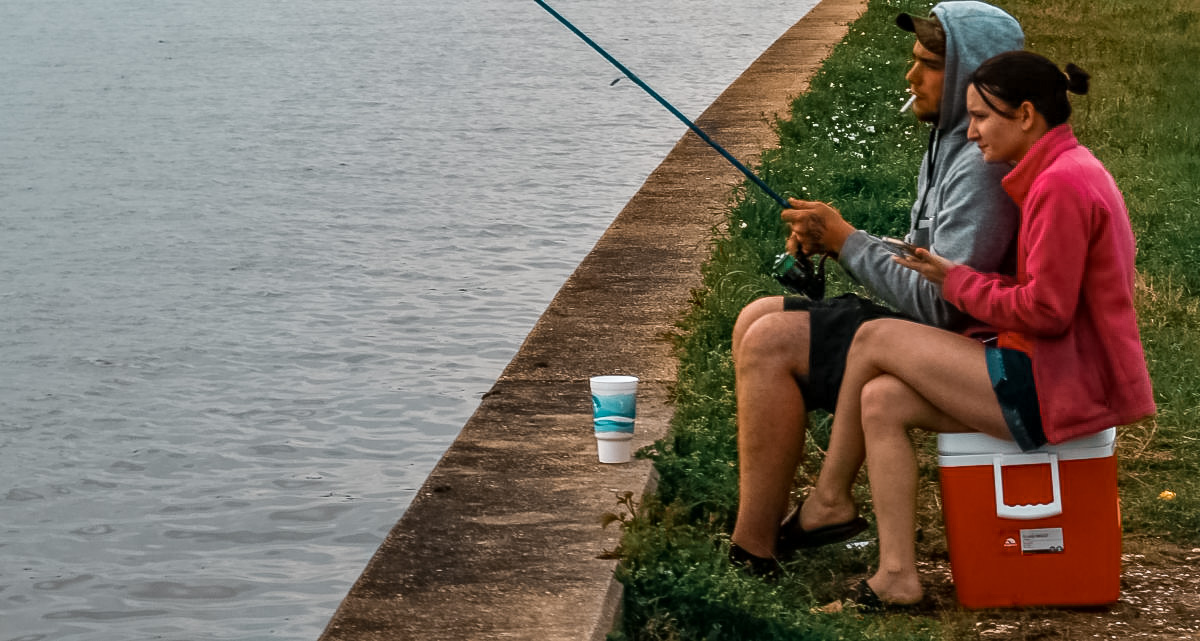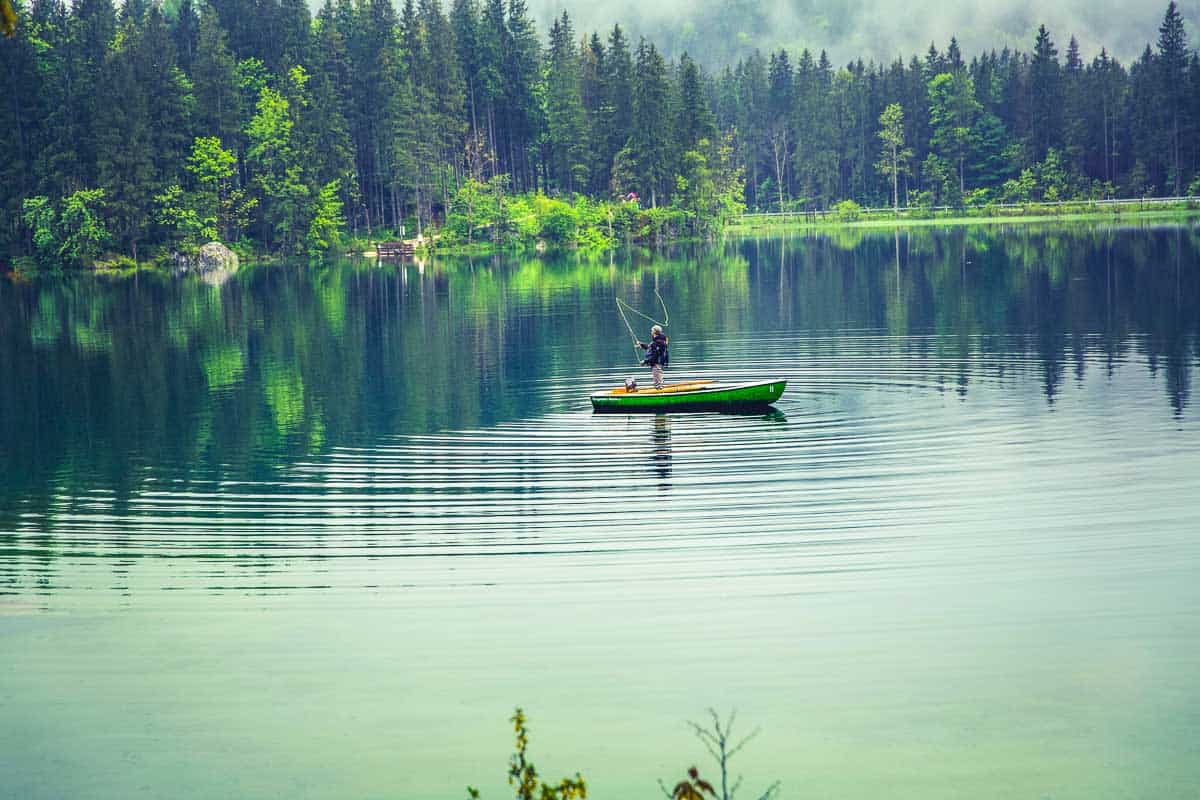There are currently more than 800 known species of freshwater fish that call North America’s lakes, rivers, and streams home. While the number is certainly impressive, so too is the diversity of species, as no two are exactly alike.
But with such a large selection at hand, it should come as no surprise that humans have tried consuming a large portion of those available. And as one could assume, some varieties of fish simply taste better than others. Thankfully, plenty of folks have done the dirty work for the rest of the population, testing out countless disgusting, dull, and delightful species, and providing info on which ones are winners, and which ones are losers.
Ready to keep a couple of fish from the boat for a fish fry? Read on to discover what the best tasting freshwater fish species are, and which species should just be thrown back.
BEST TASTING FRESHWATER FISH
BEST TASTING FRESHWATER FISH
King Salmon
LENGTH UP TO
60 inches
MASS UP TO
125 lbs.
MIN SIZE
28 inches (AK) 36 inches (CA)
BAG LIMIT
Varies by state
WHERE TO CATCH THEM
AK, WA, OR, CA, ID, MT
HOW TO CATCH THEM
Fish with fly gear in rivers, troll in lakes

King salmon ironically snatches the title of the best tasting freshwater fish, as the rich and fatty fish species offers an unbelievably likable flavor.
When it comes to delectable freshwater fish, there truly isn’t any other species that can offer quite the same flavor as King salmon. What makes the fish so special is its high fat content, dense flesh, and somewhat creamy consistency. The three factors combine to create an incredibly smooth and rich flavor, that can easily be grilled, packed into sushi, or fried.
However, due to its notoriety, King salmon can be fairly expensive to purchase, so unless an angler catches it themselves, the price for a couple of fillets can be on par with an expensive cut of steak.
Bluegill
LENGTH UP TO
16 inches
MASS UP TO
3 lbs.
MIN SIZE
7 inches
BAG LIMIT
Varies by state
WHERE TO CATCH THEM
Nationwide
HOW TO CATCH THEM
Fish lightweight worms in brushy water
Although they are a relatively small species, Bluegill are a true delicacy that almost any diner can enjoy.
Unlike many of the other freshwater fish to eat, Bluegill offers a firm fillet with a nice flaky texture. As a result, the species is ideal for creating any sort of fried fish meal, stir fry, or sauteed fillet. Such dishes further benefit from the sweet taste of bluegill, as the small species is nearly as sweet as salmon.
However, what makes bluegill a better option than other panfish such as crappie, is that they are firmer, and less likely to become mushy while cooking. The only true downside to dining on bluegill is that it takes quite a few to feed a family, rather than just one large slab like a typical salmon offers.

Yellow Perch
LENGTH UP TO
19 inches
MASS UP TO
4 lbs.
MIN SIZE
No size limit
BAG LIMIT
Varies by state
WHERE TO CATCH THEM
Great Lakes, Northeast, Northwest, Mississippi Basin
HOW TO CATCH THEM
Fish lightweight worms in brushy water

Yellow perch are an underappreciated species in so many ways, as they are not only fun to catch, but also great to eat.
Yellow perch are undoubtedly some of the best tasting lake fish to eat, as they contain firm fillets with a deep pink flesh. Once cooked, the pink flesh changes to a golden white color, while offering a moderately sweet taste. What many diners find appealing about yellow perch, is that their flavor offers little to no fishy taste, with more of a rich and hearty flavor like poultry. Like bluegill, it takes a handful of yellow perch to create a meal, but there is no question that they are some of the best lake fish to eat.
Rainbow Trout
LENGTH UP TO
35 inches
MASS UP TO
25 lbs.
MIN SIZE
8 inches
BAG LIMIT
Varies by state
WHERE TO CATCH THEM
Pacific Northwest
HOW TO CATCH THEM
Fish with fly gear in rivers, troll through lakes
Rainbow trout is one of the most common species found in North America, and no doubt one of the easiest types of freshwater fish to clean. To top things off, most rainbow trout taste pretty great, and can be used in a variety of dishes.
Trout are closely linked to salmon, as they both hail from the same genera. However, rainbow trout’s flavor is more often described as a more natural, and nutty flavor. For many diners, this may be off putting compared to salmon’s rich and creamy flavor. But with enough quality spices, and a proper method of cooking, rainbow trout can easily be considered one of the best fish to catch and eat. It’s just an added bonus that the species is likely the healthiest freshwater fish to eat.
Steelhead
LENGTH UP TO
45 inches
MASS UP TO
45 lbs.
MIN SIZE
20 inches, can only keep marked hatchery fish (WA)
BAG LIMIT
Varies by state
WHERE TO CATCH THEM
Pacific Northwest, Great Lakes, Northeast
HOW TO CATCH THEM
Fish with fly gear in rivers
Technically, steelhead and rainbow trout are the same species, at least on the molecular level. However, what sets the two apart from one another is the environment they live in, and how it affects their biology.
Steelhead spend roughly half of their lives in the ocean, then migrate back upstream to live out the rest of their days. Rainbow trout, on the other hand, are entirely confined to freshwater bodies of water. As a result, steelhead grow to be far larger, and offer more of a briny taste than rainbows.
Nevertheless, steelhead still offers a palatable and respectable flavor, that is somewhat of a hybrid between salmon and trout. It contains less fat than salmon, and offers a bit more of a flaky fillet. All in all, there is no doubt that steelhead is one of the best freshwater fish to eat, and a great substitute for salmon.

Crappie
LENGTH UP TO
20 inches
MASS UP TO
5.5 lbs.
MIN SIZE
10 inches (varies by state)
BAG LIMIT
Varies by state
WHERE TO CATCH THEM
Nationwide
HOW TO CATCH THEM
Fish small worms in shallow waters
Few fish are as easy and as fun to catch as crappie. The black and white panfish can be found all across the US, in lakes, ponds, reservoirs, and occasionally rivers. However, crappie is a pretty decent choice when it comes to freshwater fish to eat.
Crappie fillets are larger than bluegills’, requiring anglers to catch less to craft a meal. Nevertheless, the flavor is still similar, as crappie meat is white and flaky, with a bit more mushy feel. While many prefer the sweet flavor of bluegill, crappie is a fair substitute, as they possess a similar taste, and are certainly far easier to catch with an ultralight spinning rod.
Walleye
LENGTH UP TO
40 inches
MASS UP TO
20 lbs.
MIN SIZE
15 inches (varies by state)
BAG LIMIT
5 (varies by state)
WHERE TO CATCH THEM
Nationwide
HOW TO CATCH THEM
Fish live bait on trolling rigs in lakes

To the surprise of many, the not-so-innocent looking walleye is actually a pretty nice species to dine on.
Walleye is one of the healthiest freshwater fish to eat, as it is packed with protein, vitamin D, and omega-3 fatty acids. All variants of the species feed on other fish, which makes their diet relatively clean compared to many other freshwater species.
However, walleye meat can be somewhat controversial, as the flavor of the fish largely depends on where it was caught. Some anglers claim the meat to be very mild, flaky, and almost buttery, whereas others claim it to be fishier and more pungent. The best bet? Only keep walleye from clean bodies of water, as they are likely to be the best tasting.
Smallmouth Bass
LENGTH UP TO
27 inches
MASS UP TO
11 lbs.
MIN SIZE
12 inches
BAG LIMIT
Varies by state
WHERE TO CATCH THEM
Nationwide
HOW TO CATCH THEM
Fish around rocky areas, moving water, or streams
Most anglers consider it a sin to keep any species of bass, as the fish are widely regarded as the ultimate trophy catch. But what most anglers don’t realize – is that smallmouth bass are truly some of the best freshwater wild fish to eat.
Unlike largemouth bass, smallmouth are more often found in cold rivers, streams, and lakes, with circulating water. And naturally, it only makes sense that fish found in circulating water would taste better than fish found in stagnant lakes. With that being said, it is no surprise that smallmouth bass offer a cleaner and sweeter fillet than their other counterparts, with firm fillets ideal for grilling and smoking.

Northern Pike
LENGTH UP TO
60 inches
MASS UP TO
64 lbs.
MIN SIZE
24 inches (varies by state)
BAG LIMIT
Varies by state
WHERE TO CATCH THEM
Great Lakes, Pacific Northwest, Alaska
HOW TO CATCH THEM
Fish with bright colored tackle in lakes and reservoirs
Northern pike are incredibly fun to catch on a quality baitcasting reel, as they are a hefty species that puts up a mean fight. But although they look like a fearsome species with razor sharp teeth – they are actually one type of freshwater fish to eat that is often overlooked.
Cleaning pike is no easy task, but if done properly, they offer firm white meat that can be cooked in a variety of ways. Similar to many other types of fish, they are best grilled or fried, and partnered with sweet coatings or rubs.

Catfish
LENGTH UP TO
60 inches
MASS UP TO
120 lbs.
MIN SIZE
12 inches
BAG LIMIT
Varies by state
WHERE TO CATCH THEM
Nationwide
HOW TO CATCH THEM
Fish with chicken liver in lakes or rivers at night
Catfish can be really hit and miss, depending on their size, habitat, and age.
Nevertheless, a well-cooked fillet of catfish can please even the pickiest of eaters.
Unlike many of the other edible freshwater fish on this list, catfish are a species that can feed on practically anything. As a result, their flesh can become oily and somewhat greasy. But those caught in the 1-3 pound range are ideal for eating, as their flesh offers a relatively mild flavor, without an overabundance of oil.
Due to their somewhat fishy flavor, fillets from wild freshwater fish are best battered and fried with a cornmeal or breadcrumb coating.
FAQs
BEST TASTING FRESHWATER FISH
Do freshwater fish taste different from saltwater fish?
Edible freshwater fish do indeed have a very different taste compared to saltwater fish.
As the name would suggest, saltwater fish offer more of a briny and salty flavor, that tastes like that of the ocean. Granted, the severity of the saltiness varies from species to species, but that flavor is certainly far more present than it is in freshwater fish.
Freshwater fish, on the other hand, offer more of a natural fish flavor. There is little to no saltiness, and far more of an earthy and organic flavor. For some connoisseurs, that earthy flavor is a good thing, whereas others prefer the saltiness of the ocean fish. But that is not to say that all of the best tasting freshwater fish offer an earthy flavor, as some species such as salmon and smallmouth bass offer a relatively clean flavor.
The biggest difference between the two categories of fish is simply how they are prepared, as freshwater fish is almost always eaten as a main dish, whereas freshwater fish is more likely to be found as an ingredient in an ordinary meal.
What is the best tasting bass?
Smallmouth bass are widely regarded as the best tasting freshwater fish to eat from the bass family, as they have a sweeter, cleaner fillet than their close relatives.
Smallmouth bass are much more likely to be found in cool and cold streams, whereas largemouth are more likely to be found in lakes and reservoirs. However, the cool and crisp rivers and streams that contain smallmouth are often far cleaner than lakes, as the water is moving and cycling out the pollutants. As a result, smallmouth bass usually have a much cleaner and sweeter fillet than largemouth, as they feed off of a more natural habitat.
Yet, it is important to note that not all smallmouth bass can be kept and eaten, as some states have regulations. A widespread rule is that the fish must be longer than 12 inches in order to be kept, but for safe keeping it is best to research each state’s rules before keeping any freshwater fish to eat.
What is the best method to prepare freshwater fish?
Thanks to modern cooking, there are now countless ways to prepare the best tasting freshwater fish to eat.
The first, and likely most common method, is to grill the fish. Most freshwater wild fish species taste excellent after being grilled on a charcoal or gas-powered grill – assuming the chef knows what they are doing. To do so, simply get the grill to a medium-high temperature, and place the fillets skin side down. Let each piece sit for 6-8 minutes, until the skin of the fish feels nice and crisp with a spatula. The fish can then be flipped, and grilled for another 6-8 minutes on its flesh side, until is ready to eat. Fillets larger than 2 inches in width may require a few minutes extra on each side.
The second, and far less healthy option is to simply fry the fish, with a batter or just plain. To fry wild freshwater fish with a batter, simply round up some eggs, flour, and bread crumbs. Place the fish fillet in a bowl of beaten eggs, into the flour, then back into the beaten eggs. After doing so, the surface will create a somewhat glue-like substance, that will easily hold the bread crumbs. Then heat a pan with ¼ of oil to a high heat, until the oil crackles when food is dropped in. Fry each fillet for 3-4 minutes on each side, or until the outside offers a nice golden brown.
The third method for edible freshwater fish, is to smoke them. Smoking wild freshwater fish adds both salty and smoky flavors, while still complementing the natural taste of the fish. Due to the complexity of smoking fish, it is best to research what each individual smoker unit recommends, in order to best complete the process.
Which freshwater fish should I not eat?
Most freshwater fish can be eaten without much hesitation, however, there are definitely some species that should be avoided, or eaten in moderation.
Although mercury poisoning is frequently thrown around when talking about freshwater fish, the reality is that the likelihood is fairly low. In order to actually become poisoned by the element, a person would have to consume freshwater fish from a hazardous site weekly. While it is still possible, it is highly unlikely – so a handful of freshwater wild fish each month certainly doesn’t warrant much concern.
For the most part, the fish that people want to likely avoid are those such as carp, large catfish, and older gamefish. While carp is full of bones and incredibly difficult to prepare, large catfish and older gamefish are more likely to contain pollutants, such as mercury and other harmful chemicals. Catfish is best eaten at 1-3 lbs., as it typically becomes very oily and fatty after exceeding that weight.
What is the best tasting freshwater fish?
There is a pretty general consensus across the globe that the best tasting freshwater fish is salmon.
Although there are countless different species of salmon, they all have one thing in common – that they offer an incredible flavor. Some species have a higher fat content and richer flavor, such as the King salmon, whereas others like the Silver salmon offer a more subtle flavor that can blend with other ingredients. Luckily, each of the different types can be purchased in most regions of US, although the freshest and most tasty are likely found in the Pacific Northwest.
All in all, it’s no surprise that the King salmon really is the best tasting freshwater fish, as it dominates food markets, high-end restaurants, and dinner tables across the nation.
BEST TASTING FRESHWATER FISH
SOURCES
- How to Smoke Salmon – honest-food.net
- Freshwater Fish – nationalgeographic.com
- Walleye (Pickerel) – gov.nt.ca
- How Many Species of Salmon Are There and How Large Can They Get? – usgs.gov
- What is King Salmon? – thespruceeats.com
- Trout, Rainbow – seafoodsource.com
- Public Health Statement for Mercury – atsdr.cdc.gov
REACH OUT
As always, we create our content with you, fellow divers, in mind. So, how’d we do? Did you find this informative? Did it help you make a decision? Did we miss anything? We’d love to hear from you below. Thanks for reading and we hope your next dive is a great one!


